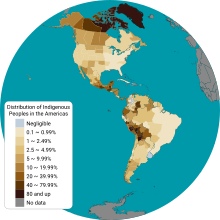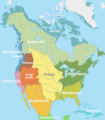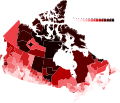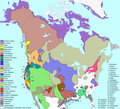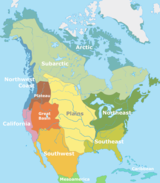The Indigenous peoples of the Americas PortalThe Indigenous peoples of the Americas are groups of people native to a specific region that inhabited the Americas before the arrival of European settlers in the 15th century and the ethnic groups who continue to identify themselves with those peoples. The Indigenous peoples of the Americas are diverse; some Indigenous peoples were historically hunter-gatherers, while others traditionally practice agriculture and aquaculture. In some regions, Indigenous peoples created pre-contact monumental architecture, large-scale organized cities, city-states, chiefdoms, states, kingdoms, republics, confederacies and empires. These societies had varying degrees of knowledge of engineering, architecture, mathematics, astronomy, writing, physics, medicine, planting and irrigation, geology, mining, metallurgy, sculpture and gold smithing. ( Full article...) Selected article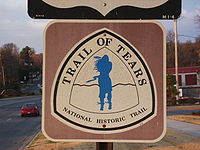 The Trail of Tears is a name given to the forced relocation of Native American nations from southeastern parts of the United States following the Indian Removal Act of 1830. The removal included many members of the following tribes, who did not wish to assimilate: Cherokee, Muscogee, Seminole, Chickasaw, and Choctaw nations, among others, from their homelands to Indian Territory west of the Mississippi River. The Native Americans who chose to stay and assimilate were allowed to become citizens in their states and of the U.S. The phrase "Trail of Tears" originated from a description of the removal of the Choctaw Nation in 1831. Many Native Americans suffered from exposure, disease and starvation on the route to their destinations. Many died, including 2,000-6,000 of 16,542 relocated Cherokee. European Americans and African American freedmen and slaves also participated in the Chickasaw, Choctaw, Muscogee Creek and Seminole forced relocations. Selected imageGeneral imagesThe following are images from various Indigenous peoples of the Americas-related articles on Wikipedia.
Selected biography Sacagawea ( /ˌsækədʒəˈwiːə/ see below; c. 1788 – December 20, 1812; see here for other theories about her death), also Sakakawea or Sacajawea, was a Lemhi Shoshone woman, who accompanied the Lewis and Clark Expedition, acting as an interpreter and guide, in their exploration of the Western United States. She traveled thousands of miles from North Dakota to the Pacific Ocean between 1804 and 1806. She has become an important part of the Lewis and Clark legend in the American public imagination. The National American Woman Suffrage Association of the early twentieth century adopted her as a symbol of women's worth and independence, erecting several statues and plaques in her memory, and doing much to spread the story of her accomplishments. In 2000, the United States Mint issued the Sacagawea dollar coin in her honor, depicting Sacagawea and her son, Jean Baptiste Charbonneau. The face on the coin was modeled on a modern Shoshone- Bannock woman named Randy'L He-dow Teton. No contemporary image of Sacagawea exists. In 2001, she was given the title of Honorary Sergeant, Regular Army, by then-president Bill Clinton. Did you know…
SubcategoriesRelated portalsThings you can do
Selected panoramaTopicsRecognized content
Featured articlesFormer featured articlesGood articles
Former good articlesDid you know? articles
In the News articlesAssociated WikimediaThe following Wikimedia Foundation sister projects provide more on this subject:
American indigenous language WikipediasAvañe'ẽ (Warani) · Aymar aru (Aymara) · ᏣᎳᎩ (Cherokee) · Chahta (Choctaw) · ᐃᔨᔫ (Cree) · ᐃᓄᒃ (Inuktitut) · Iñupiak · Kalaallisut (Greenlandic Inuit) · Mvskoke (Muscogee) · Nahuatlahtolli · Diné bizaad (Navajo) · Qhichwa Simi · Tsêhesenêstsestôtse (Cheyenne) Indigenous languages in Wikimedia Incubators: Alabama · Blackfoot · Chinook Jargon · Choctaw · Creek · Lakota · Micmac · Mohawk · Nheengatu · Northwestern Ojibwa · O'odham · Shoshoni · Unami-Lenape · Wüne pakina (Mapudungun) · Yucatec Maya · Central Alaskan Yup'ik · Zuni |
